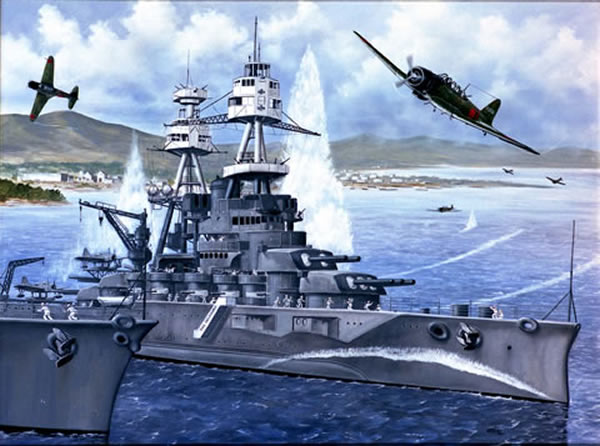Siege of Battleship Oklahoma at Pearl Harbor

Artist: R.T. Foster
Sponsor: Admiral and Mrs. William Crowe
Dedication: April 18, 2001
Size: 48" x 36"
Type: Acrylic on Canvas
Location: 5th floor, South hall, House wing
On December 5, 1941, the Oklahoma and the Battle Fleet of the U.S. Pacific Fleet were ordered back to Pearl Harbor as conditions with the Imperial Government of Japan continued to deteriorate.
On that Sunday, December 7, 1941, the Battle Fleet was at its mooring in Pearl Harbor. The Oklahoma was preparing for an Admiral's Inspection scheduled for Monday, December 8th. Therefore, all hatches were open and all guns had been broken down for cleaning. The ship was moored outboard of the battleship Maryland. During the attack, the Oklahoma took three to seven torpedoes to her side. Due to the hatches being open, the ship started to take on water and capsized in less than ten minutes. Over 400 men were either killed instantly or drowned. Rescue attempts started at once following the attack and 32 sailors were saved. The crew compliment consisted of 83 officers, 1215 enlisted navy, 3 U.S. Marine officers, and 64 enlisted Marines, for a total of 1,365.Following the attack, the Navy decided to right the Oklahoma as it was blocking the sea channel. Bodies that were found were removed and interned at the "Punchbowl National Cemetery" in Hawaii. The once proud ship was stripped and sold for scrap at a price of $46,000.00. While under tow, the Oklahoma developed a list and about mid-point between Pearl Harbor and San Francisco, she plunged to the bottom of the Pacific Ocean.
Oklahoma was authorized by Congress in 1911 and thekeel was laid in 1912, at the New York Ship Building Yard. Miss Lorena Cruce, daughter of Oklahoma Governor Lee Cruce, christened the Oklahoma at Camden, New Jersey, on the 23rd of March. In 1917, the Oklahoma was commissioned, at a cost of approximately $15 million, as a ship in the United States Naval Service. It joined the fleet in 1918 and escorted Allied shipping to Europe. It never fired its guns in war time. After the war, the Oklahoma was escort to President Woodrow Wilson back from France following the Treaty of Versailles.
Images are copyright of The Oklahoma State Senate Historical Preservation Fund, Inc. and the artist. Please contact Matt Duehning at 405-524-0126 or Matt.Duehning@oksenate.gov for further copyright information.
 Oklahoma Senate
Oklahoma Senate

